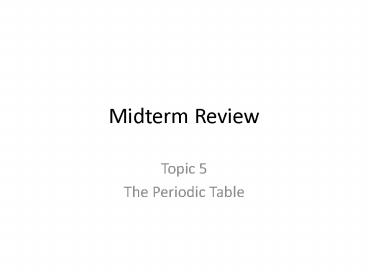Midterm Review - PowerPoint PPT Presentation
1 / 17
Title:
Midterm Review
Description:
Midterm Review Topic 5 The Periodic Table Vocabulary Classifying Elements Dmitri Mendeleev Arranged elements in order of increasing atomic mass, similar chemical and ... – PowerPoint PPT presentation
Number of Views:141
Avg rating:3.0/5.0
Title: Midterm Review
1
Midterm Review
- Topic 5
- The Periodic Table
2
Vocabulary
- Atomic radius
- Electronegativity
- Family
- Group
- Ionic radius
- Ionization energy
- Metal
- Metalloid
- Noble gas
- Nonmetal
- Periodic law
- Period
3
Classifying Elements
- Dmitri Mendeleev
- Arranged elements in order of increasing atomic
mass, similar chemical and physical properties
4
Classifying Elements
- Modern Periodic Table
- Arranged according to the modern periodic law
- The properties of the elements are periodic
functions of their atomic number
5
Table Information about the Elements
6
Arrangement of the Periodic Table
- Periods
- Horizontal rows of the table
- In each row the number of valence electrons
increase form left to right
7
Arrangement of the Periodic Table
- The elements are located by other elements that
have common properties - Metals are on the left side of the table
- Nonmetals are on the right side of the table
- Metalloids are in between the metals and the
nonmetals
8
Arrangement of the Periodic Table
- Groups or families
- Vertical columns
- All members of the group contain the same number
of valence electrons - Having the same number of valence electrons give
the elements similar chemical properties
9
Types of Elements
- Metals
- The most active metals are in group 1 and 2
- General properties of metals
- Metals are solid at room temp, except for Hg
- Most of the metals have densities greater than
water, except for group 1 - Metals are malleable
- Metals are ductile
- Metals have luster
- Metals are good conductors of heat and
electricity (sea of mobile electrons) - Metals have relatively low ionization energies
and electronegativity values - Metals tend to lose electrons to form positive
ions with smaller radii
10
Types of Elements
- Metalloids
- B, Si, Ge, As, Sb, and Te
- Represent an intermediate type of element,
displaying both metallic and nonmetallic
properties
11
Types of Elements
- Nonmetals
- General properties of nonmetals
- Many nonmetals are gases or a solid except for
Br2 being a liquid - Nonmetals are not malleable or ductile they tend
to be brittle in the solid phase - Solid nonmetals lack luster, and their surface
appears dull - Nonmetals have high ionizations energies and high
electronegativity values - Nonmetals are poor conductors of heat and
electricity - Nonmetals tend to gain electrons to become
negative ions with radii larger then their atoms
12
Types of Elements
- Noble Gases
13
Properties of Elements
- Ionization energy
- The amount of energy needed to remove the most
loosely bound electron form a neutral gaseous
atom
14
Properties of Elements
- Atomic Radii
- Half the distance between nuclei of identical
atoms that are bonded together
15
Properties of Elements
- Ionic Radii
- Gain electrons it gets bigger
- Loose electrons it gets smaller
16
Properties of Elements
- Electronegativity
- Is an measure of an atoms attraction for
electrons when bonded to another atom. - Cs has the lowest
- F has the highest (4.0)
17
(No Transcript)































